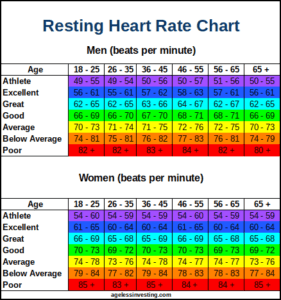What’s one of the simplest yet most revealing measures of your health?
It might just be your resting heart rate (RHR) – how fast your heart beats when you’re truly relaxed. While age plays a role, your RHR offers powerful insights into your cardiovascular fitness and even potential longevity.
Check the resting heart rate chart below to see where you stand, and explore factors influencing RHR and natural ways to potentially improve it. Can simple changes help you lower your RHR and potentially reduce health risks?
Let’s find out how to understand and potentially improve your pulse.
Resting Heart Rate Chart By Age And Gender
A resting heart rate chart shows the typical range based on age and general physical condition. Athletes often have a lower RHR than less active individuals. While average heart rate tends to increase slightly with age, factors like activity, stress, and time of day cause moment-to-moment variations.

Normal Resting Heart Rate For Kids
| Newborns (0-1 month) | 70 to 190 bpm |
| Infants (1-11 months) | 80 to 160 bpm |
| Children (1-2 years) | 80 to 130 bpm |
| Children (3-4 years) | 80 to 120 bpm |
| Children (5-6 years) | 75 to 115 bpm |
| Children (7-9 years) | 70 to 110 bpm |
| Children 10+ & Adults | 60 to 100 bpm |
Data based on information from the National Institutes of Health (NIH).
What Is Resting Heart Rate (RHR)?
Your resting heart rate (RHR) is how many times your heart beats in one minute while you’re resting. It’s both a gauge of your heart health and a biomarker of aging.
RHR changes as you age and varies from person to person. Knowing your RHR is important as it can help you assess your heart health over time. Being aware of changes in your RHR can help you uncover a heart condition early.
What Is a Good Resting Heart Rate By Age?
A healthy resting heart rate is about 60 beats per minute, but this number varies with age. The normal range for a resting heart rate is between 60 bpm and 100 bpm. Well-conditioned athletes, however, could have a resting heart rate of 40 bpm.
Resting Heart Rate vs. HRV and Blood Pressure
Resting heart rate, heart rate variability, and blood pressure are all important measures of heart health.
- Resting heart rate (RHR): is the number of times your heart beats per minute while resting.
- Heart rate variability (HRV): measures the variation in the time between consecutive heartbeats.
- Blood pressure: is the force of blood flowing through your blood vessels (Ref. 1).
How to Measure Resting Heart Rate Accurately
- Wait until you’re relaxed. If you’ve just finished exercising or you’re stressed, your pulse rate will be elevated.
- Place your index finger and middle finger on one of your pulse points to take your pulse.
- Count the number of heartbeats for 30 seconds, then multiply by two.
What is the ideal time to take a resting heart rate?
The best time to take your resting heart rate is when you wake up before you leave the bed. Check your RHR simultaneously and in the same rested state daily for an accurate reading.
You can also measure your heart rate (HR) right after exercise to track your maximum heart rate.
Where Are the Best Places to Check Your Pulse?
The best places to check your heart rate are the following (Ref. 2):
- your wrist
- the side of your neck
- the inside of your elbow
- the top of your foot
How to Check Your Pulse Video
Watch Emily Reeve, the Senior Cardiac Nurse at the British Heart Foundation, show how to check your pulse.
What is a Normal or High Resting Heart Rate?
A normal resting heart rate for adults is between 60 beats per minute (bpm) and 100 bpm (Ref. 2). An abnormal pulse rate below 60 or above 100 bpm could increase your risk of cardiovascular disease, stroke, or early death.
Normal Resting Heart Rate for Women
The normal resting heart rate for adult women is similar to men, between 60 bpm and 100 bpm. Age and activity level are more important factors for heart rate.
Studies show that having a high resting heart rate increases your risk even after controlling for other factors such as physical fitness, blood pressure, and lipid levels (Ref. 3).
Is a resting heart rate of 80 bad? A bpm of 80 is still within the normal range, but over 90 can be dangerous.
For example:
One study tested the resting heart rate of about 3,000 men over 16 years old. After accounting for other risk factors, the study found that men with a resting heart rate over 90 bpm were three times more likely to die than men with the lowest RHR.
Further, an increased heart rate over time is associated with an increased risk of death from heart disease and all-cause mortality (Ref. 4).
Is A Low Resting Heart Rate Good Or Dangerous?
A low resting heart rate could be dangerous. It could indicate an underlying heart problem if you’re not an athlete.
Even if you’re an athlete, it could be a problem. One study found that having a low resting heart rate is a risk factor for atrial fibrillation (AF) in athletes (Ref. 5).
A heart rate below 60 bpm doesn’t mean you’re not healthy. For example, a low RHR could be caused by taking drugs such as beta blockers (Ref. 2).
Athletes generally have lower heart rates. Active people have lower heart rates because they have stronger and more efficient hearts. Their hearts don’t need to work as hard to circulate blood throughout the entire body.

What is A Dangerous Resting Heart Rate?
A resting heart rate can be dangerous if it’s too fast (tachycardia) or too slow (bradycardia). Tachycardia is generally over 100 bpm, and bradycardia is generally below 60 bpm (for non-athletes). A resting heart rate that is too fast or too slow could result in a serious health problem.
What Is Tachycardia?
Tachycardia is a resting heart rate that is too fast (Ref. 6). It can be caused by congenital heart disease, poor circulation, anemia, hypertension, or injury to the heart, such as a heart attack (Ref. 7). Tachycardia is also associated with a shorter life expectancy (Ref. 8).
What Is Bradycardia?
Bradycardia is a slow resting heart rate (Ref. 9). It can be caused by hypotension, congenital heart disease, damage to the heart (from heart disease, heart attack, or aging), chronic inflammation, or myocarditis (a heart infection).
A resting heart rate that’s too high or too low for an extended period can cause dangerous health conditions such as heart failure, blood clots, fainting, and sudden cardiac arrest.
If your resting heart rate is consistently above 100 bpm or below 60 bpm (if you aren’t an athlete), you should see your doctor or medical provider. Additionally, it would be best to watch for symptoms such as fainting, shortness of breath, dizziness or light-headedness, chest pain, discomfort, or fluttering.
What Factors Affect Resting Heart Rate?
- Temperature: When temperature and humidity rise, your heart needs to pump more blood. Your pulse may increase up to 5 to 10 bpm (Ref. 2).
- Body position: Your pulse is usually the same when resting, whether sitting or standing. However, it may go up for a few minutes after sitting or standing.
- Emotions: Being stressed, excited, or upset can raise your pulse.
- Body Size: If you’re obese, your heart rate could be higher than average as your heart needs to work harder to circulate throughout your body.
- Medications: Drugs that block your adrenaline (beta-blockers) can slow your heart rate (Ref. 2). Conversely, high doses of thyroid medication can raise it.
- Hydration: Being dehydrated raises your RHR (Ref. 10).
- Type 2 Diabetes: Is associated with resting heart rate (Ref. 11).
Does Your Heart Have a Maximum Number of Beats?
The maximum number of lifetime heartbeats for humans is about 3 billion. But you won’t die when you reach a set number of heartbeats. Heartbeats, however, are a marker of your metabolic rate—the faster your metabolic rate (how fast you age), the shorter your lifespan.
For example:
The total number of heartbeats per lifetime is amazingly similar across all mammals. For instance, a mouse has a heart rate of 500 to 600 beats per minute but lives less than two years (Ref. 12).
At the other extreme, a Galápagos tortoise has a heart rate of about six beats per minute and a life expectancy of 177 years.
A mouse’s heart beats about 100 times faster than a tortoise’s. But a tortoise lives 100 times longer than a mouse. Humans, however, have about 60 bpm and have about 3 billion heartbeats per lifetime.
If You Slow Your Resting Heart Rate, Can You Slow Down Aging?
Having a lower resting heart rate is associated with a longer lifespan.
Athletes generally have a lower resting heart rate due to their physical fitness.
One study found that the more physically fit you are, the lower the resting pulse (Ref. 13). The same study found that even controlling for physical fitness, people with a higher resting heart rate had a shorter life expectancy than those with a lower one.
So a high resting heart rate is not just a marker of risk but a risk factor for premature death. The difference between a risk marker and a risk factor is that if you can control the risk factor, you can control the risk.
Why Is A High Resting Heart Rate Dangerous?
If your heart is beating fast 24 hours a day, all that circulatory stress can damage the elastic fibers supporting your arterial walls, making them stiff (Ref. 14). Your arteries do not have enough time to relax between beats (Ref. 15).
What Is An Optimal Resting Heart Rate?
An optimal heart rate is about one beat per second (60 bpm) at rest (Ref. 16). For every ten beats per minute increase, there’s a 10 to 20% increased risk of premature death.
Strong evidence shows that everyone with a high heart rate is at risk, even otherwise healthy individuals (Ref. 17). But there are ways that you can slow your heart rate naturally.
First, check your resting heart rate before you make any changes using the method described earlier. This reading will be your baseline number to track your progress and test which programs work for you. Secondly, record your heart rate after making any changes.

How to Lower Resting Heart Rate Naturally
- Exercise Regularly: Exercise temporarily raises your heart rate, but your body becomes more efficient over time. Your resting heart rate should lower naturally.
- Manage Stress: Meditation and other stress management techniques like tai chi help your body reach a deeper, relaxed state, lowering resting heart rate.
- Avoid Smoking: Smokers generally have higher resting heart rates, but quitting can bring it back to normal (Ref. 18).
- Maintain a Healthy Weight: Your heart circulates blood throughout your body. The larger the body, the harder the heart must work. Losing weight reduces your body size and brings down your resting heart rate.
- Eat A Heart-Healthy Diet: A whole food plant-based diet, especially one including beans, can lower resting heart rate naturally (Ref. 20).
- Stay Hydrated: Drinking enough water generally lowers RHR and activates your parasympathetic nervous system (Ref. 10).
Exercise and Resting Heart Rate
One study involved participants in a 12-week aerobic conditioning program using cycling, Stairmaster, and treadmill running.
Participants dropped their resting heart rate from an average of 69 to 66 bpm (Ref. 19). But when they stopped the program, their resting heart rate returned to around 69 again.
You must exercise consistently to keep your resting heart rate lower.
Foods That Lower Resting Heart Rate
People in the Blue Zones live longer than average and eat plenty of beans. Beans are healthy because they can help lower one’s pulse.
In one study, participants given a cup of beans, chickpeas, or lentils daily lowered their resting heart rate from an average of 74.1 to 70.7 bpm (Ref. 20). Consider eating beans regularly to keep your resting heart rate in a healthy range.

Try the “Legs Up the Wall” Yoga Pose (Viparita Karani)
The legs up the wall pose (Viparita Karani) is a therapeutic yoga pose that helps relax your body and mind. To do the Viparita Karani pose:
- Find a comfortable spot near a wall.
- Move your hips as close to the wall as possible.
- Slide your feet up the wall until your legs are roughly parallel to the wall.
- Relax and inhale deeply and slowly through your nose and exhale slowly through your nose.
Try to stay in this pose for 5 minutes. Relaxing with your legs elevated helps improve circulation as gravity assists blood flow from your legs back to your heart, reducing its workload and lowering your heart rate.
Consider High-Intensity Interval Training (HIIT)
HIIT involves giving 100% effort in a quick, intense burst of exercise, followed by a short resting period. HIIT increases your maximum heart rate and can lower your RHR over time.
Example: Sprint as fast as possible for 30 seconds, then rest for 90 seconds. Warm up first and start with just one repetition. Rest fully between HIIT sessions. Build slowly. Listen to your body: push to *your* max, then recover fully before the next interval.
How Long Does it Take to Lower Resting Heart Rate?
It typically takes about 12 weeks of consistent effort (diet, exercise) to see significant changes in resting heart rate (Ref. 19, 20).
Your body needs time to adapt (enlarging heart muscle, increasing red blood cells/capillaries/mitochondria). However, relaxation techniques like slow, deep breathing can lower your heart rate momentarily.
Final Thoughts: Make Your Heartbeats Count
- Your RHR is a key health indicator linked to longevity.
- A lower RHR generally suggests better cardiovascular efficiency.
- Lifestyle choices (exercise, diet, stress, hydration, weight) directly impact RHR.
- Consistent healthy habits can lower your RHR over time.
- Simple activities like walking, eating beans, and relaxation techniques can help.
- Monitor your RHR to track progress and understand your body.

Important Health Disclaimer
This article provides general information and is not medical advice. Science evolves, and individual circumstances vary. Always consult your healthcare provider before making significant changes to your health routine, diet, or exercise, especially if you have existing medical conditions or concerns about your heart rate.
Read the full medical disclaimer here.
Related Posts
Sources Cited
- American Heart Association. (Date Accessed). Blood Pressure vs. Heart Rate (Pulse). Link
- American Heart Association. (Date Accessed). All About Heart Rate (Pulse). Link
- Zhang, D., Shen, X., & Qi, X. (2016). Resting heart rate and all-cause and cardiovascular mortality… *CMAJ*, 188(3), E53–E63. Link (*Note: Link abstract differs*)
- Cooney, M. T., Vartiainen, E., Laakitainen, T., et al. (2010). Elevated resting heart rate is an independent risk factor… *American heart journal*, 159(4), 612–619.e3. Link (*Note: Link abstract differs*)
- Aizer, A., Gaziano, J. M., Cook, N. R., et al. (2014). Relation of resting heart rate to risk of developing atrial fibrillation in women. *The American journal of cardiology*, 113(10), 1649–1653. Link (*Note: Link abstract differs*)
- American Heart Association. (Date Accessed). Tachycardia: Fast Heart Rate. Link
- Freeman, J. V., Wang, Y., Curtis, J. P., et al. (2012). Physician procedure volume and complications following pacemaker implantation. *Circulation*, 125(1), 57–65. Link (*Note: Link abstract differs*)
- Jensen, M. T., Suadicani, P., Hein, H. O., & Gyntelberg, F. (2013). Elevated resting heart rate, physical fitness and all-cause mortality… *Heart*, 99(12), 882–887. Link (*Note: Link abstract differs*)
- American Heart Association. (Date Accessed). Bradycardia: Slow Heart Rate. Link
- Pichot, V., Roche, F., Celle, S., et al. (2016). Fluid intake and arterial haemodynamics in the elderly. *Gerontology*, 62(5), 521–529. Link (*Note: Link abstract differs*)
- Böhm, M., Schumacher, H., Leong, D., et al. (2015). Relationship between resting heart rate and cardiovascular outcomes in diabetic patients… *European heart journal*, 36(42), 2839–2848. Link (*Note: Link abstract differs*)
- Levine, H. J. (1997). Rest heart rate and life expectancy. *Journal of the American College of Cardiology*, 30(4), 1104–1106. Link
- (Duplicate Ref 3) Cooney, M. T., Vartiainen, E., Laatikainen, T., et al. (2010). Elevated resting heart rate is an independent risk factor… *American heart journal*, 159(4), 612–619.e3. Link
- Cook, S., Togni, M., Schaub, M. C., et al. (2006). High heart rate: a cardiovascular risk factor?. *European heart journal*, 27(20), 2387–2393. Link (*Note: Link abstract differs*)
- Custodis, F., Schirmer, S., Baumhäkel, M., et al. (2010). Vascular pathophysiology in response to increased heart rate. *Journal of the American College of Cardiology*, 56(24), 1973–1983. Link (*Note: Link abstract differs*)
- (Duplicate Ref 7) Freeman, J. V., Wang, Y., Curtis, J. P., et al. (2012). Physician procedure volume and complications following pacemaker implantation. *Circulation*, 125(1), 57–65. Link
- Zhang, G. J., & Zhang, S. L. (2009). Resting heart rate is an independent predictor of all-cause mortality… *Chinese medical journal*, 122(12), 1328–1334. Link (*Note: Link abstract differs*)
- Harvard Health Publishing. (2011). Increase in resting heart rate is a signal worth watching. Link
- Cornelissen, V. A., Verheyden, B., Aubert, A. E., & Fagard, R. H. (2010). Effects of aerobic training intensity on resting, exercise and post-exercise blood pressure, heart rate and heart-rate variability. *Journal of human hypertension*, 24(3), 175–182. Link (*Note: Link may require access*)
- Jayalath, V. H., de Souza, R. J., Sievenpiper, J. L., et al. (2014). Effect of dietary pulses on blood pressure… *American journal of hypertension*, 27(1), 56–64. Link (*Note: Link may require access*)



I’ve heard this technique before, good to know there is actually a wealth of science to back it up!
Thank you, I try to back what I say with science when I can. It not only forces me to question outdated beliefs but I find ideas that I wouldn’t come across otherwise.
Your first paragraph says a heart rate of 60 beats per second is normal. That would be 3600 BPM. I only got mine this high one time when I sprinted to the top of Mount Everest and back down again all in one workout session.
Thank you for the correction, Jeremy. It should read “60 beats per minute.”
Great article. Thank you.
Thank you, I try to update when I learn something new.
…and awesome name…
Haha, and please let me know a health-related topic that you would love to see me cover in another in-depth post.
Wow quite an impressive article. You’re definitely an expert in this field.
Thank you, Mary! I’m not an expert, but I know how to research the work of experts. I love to find interesting facts about health such as resting heart rate and share what I learn. I want to democratize health information to allow everyone to, with the counsel of their doctor, make an informed decision.
Hi Jeremy. Great article! Where did you source the information for the resting heart rate chart? I’m hoping to reference it appropriately. Cheers
Thank you, Jordan! I can’t find the original source right now. I will update with it as soon as I can.
What’s a normal pulse rate for a woman?
Thank you for your question, Samuel. According to Harvard Health, the normal pulse rate for a woman is between 60 to 100 beats per minute. That number also depends on several factors such as age and fitness level.
Pingback: Whats The Average Heartbeat Per Min | Lezat
I love this article. It is the most concise assessment of heart health I’ve read in a long time. I stumbled upon this looking for current research about resting heart rate in women over 60. This will be shared. Thank you.
Thank you, Suzanne!!
I try to update frequently. I’m also working on a blood pressure post, check back soon.
I’m 74 and have changed my lifestyle significantly with COVID precautions having being introduced.
I am now walking 16 miles 3 – 4 times a week over 5 hrs largely through forests and on sandy beaches. I am lunching on egg omlettes or salmon, with a diverse selection of vegetables (fried in olive oil – runner beans, onions, courgettes, leeks, celery & tomatoes), with boiled carrots and broccoli. I have fruit & nut muesli with soya milk for breakfast, plus a banana. Have 6 – 8 mugs of decaf tea daily.
After 10 months, my RHR is 40, BP 115/60
Thank you, Stephanie!!! Wow, you’re an inspiration!
What was your RHR and BP to begin with?
Pingback: Work Smarter Not Harder! | Biomechanics in the Wild